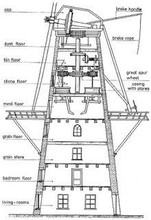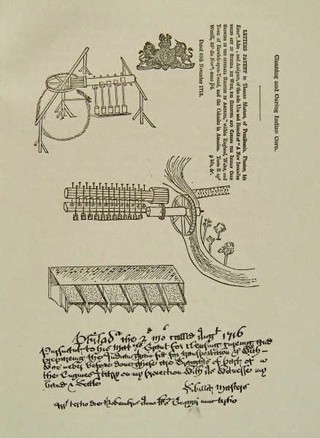Sybilla Righton Masters
Introduction
Text-to-speech Audio
Sybilla Righton Masters is the first known person to receive two English patents for her inventions. She also is the first documented female machinery inventor in America. The two patents were for her Tuscarora Rice invention and her process of weaving straw and palmetto. She received her first patent in 1715 and her second patent in 1716. However, during these times women were not allowed to have a patent, so thankfully for her husband we were able to have this information.
Images
Tuscarora Rice Design Layout

How the Mill Process Worked

Backstory and Context
Text-to-speech Audio
After Sybilla Righton Masters watched an American Indian women pound corn using wooden mallets, what started out as an idea is now something that is commonly used today. The Tuscarora Rice mill was invented which is a corn processing mill which produced corn meal. With the inspiration from the American Indian women’s process, the Tuscarora Rice mill processed corn differently than other mills during that time. This mill pulverized corn instead of grinding it. The mill used hammers to make cornmeal which was essentially easier than millstones (Barrett). The mill had long wooden cylinder with projections on each side which would cause a series of heavy pestles to drop on mortars filled with corn kernels, which was powered by horses and water wheels (“Isabella Sybilla (Righton) Masters.”).
After the Tuscarora Rice was invented, Masters wanted a patent for it to secure that this invention was hers and no one would be able to copy her idea. There were two problems she encountered: one being that only men could obtain patents and secondly, only a few countries had patents. She was living in Philadelphia, PA at the time and discovered that the United States was not one of the countries that did patents. However, England did patents so, she and her husband, Thomas Masters, sailed to England in 1712 (“Sybilla Masters Level 1.”).
Once they arrived, they hopped they could sell this cornmeal to the English market but, they were not able to. Originally the name “Tuscarora Rice” was falsely advertised and was sold as a cure for tuberculosis (Barrett). However, she stilled received her first patent on November 25th, 1715, by King George I of Great Britain. She was able to obtain her patent for the process of it being a way of “Cleaning and Curing The Indian Corn Growing in the several Colonies of America” (“Sybilla Righton Masters.”). Although she was able to receive a patent, it could not go under her name because she was a female. So, it went under her husbands name and he stayed loyal and did not take credit for her invention. He stated in the first patent submission that this was not his doing, it was all his wife’s doing (“Sybilla Righton Masters.”). After receiving the patent, they went home and Thomas built her mill which took off in the United States and is still a popular method to this day (“Sybilla Masters Level 1.”). However, her invention did not do well in England because the English did not like the taste of the American grits (The Exasperated Historian).
On February 8th, 1716, Masters received her second patent for her process of weaving straw and palmetto. This process was “Working and Weaving in a New Method, Palmetto Chip and Straw for Hats and Bonnets and other improvements of that Ware” (Jansen). The letter for the patent noted “a new way of working and straining in straw, and the plat and leaf of the palmetto tree, and covering and adorning hats and bonnets in such a manner as was never before done or practiced in England or any of our plantations” (Jansen). The straw and palmetto leaves were made to form and stain for the adornment of women’s hats and bonnets. Sadly, there are not diagrams or drawing of this invention or process (“Sibilla Masters Biography (c. 1670-1720).”). This process was also used to create many other woven goods like baskets, matting, and furniture coverings (“Isabella Sybilla (Righton) Masters.”).
One month after receiving the patent that had to be under Thomas Masters name, Masters opened a shop in London called West India Hat and Bonnet. At the shop, people were able to buy pieces and furniture padding which was made from her straw and leaf treatment (“Sibilla Masters Biography (c. 1670-1720).”). Once the shop was short lived, they returned back to Philadelphia and Thomas petitioned for recognition of Masters’s British patent. They got reissued because Pennsylvania colony was just starting to approve its own patents (Jansen). Thanks to her husband and his honesty, we were able to have the correct information and correct recognition for Masters and her inventions. She remained the only woman to have patents up until 1793 once Hannah Wilkinson Slater was issued a patent for a cotton thread to be used in her husband’s factories (Jansen). Masters is also the only woman, first and last colonial woman from modern United States to receive an English patent (The Exasperated Historian).
Cite This Entry
Churilla, Lauren, Amanda Zrile, and Clio Admin. "Sybilla Righton Masters." Clio: Your Guide to History. June 23, 2022. Accessed August 9, 2025. https://theclio.com/entry/143298
Sources
- Barrett, Pru. “Sybilla Righton Masters (c 1676 -1720).” The Mills Archive, 16 Feb. 2021, https://new.millsarchive.org/2020/11/03/sybilla-righton-masters-c-1676-1720/.
- The Exasperated Historian, http://theexasperatedhistorian.com/the-womens-list/413-sybilla-righton-masters/.
- “Isabella Sybilla (Righton) Masters.” WikiTree, 15 Aug. 2020, https://www.wikitree.com/wiki/Righton-17.
- Jansen, Sharon L. “Sybilla Masters, American Inventor.” Sybilla Masters, American Inventor, 1 Jan. 1970, https://www.monstrousregimentofwomen.com/2016/04/sybilla-masters-american-inventor.html.
- “Sibilla Masters Biography (c. 1670-1720).” How Products Are Made, http://www.madehow.com/inventorbios/43/Sibilla-Masters.html.
- “Sybilla Masters Level 1.” Pennsylvania People, https://pennsylvaniapeople.weebly.com/sybilla-masters-level-1.html.
- “Sybilla Righton Masters - Google Arts & Culture.” Google, Google, https://artsandculture.google.com/entity/sybilla-righton-masters/m0r8ky20?categoryid=historical-figure.
- “Sybilla Righton Masters.” Wikipedia, Wikimedia Foundation, 19 Dec. 2020, https://en.wikipedia.org/wiki/Sybilla_Righton_Masters.
Barrett, Pru. “Sybilla Righton Masters (c 1676 -1720).” The Mills Archive, 16 Feb. 2021, https://new.millsarchive.org/2020/11/03/sybilla-righton-masters-c-1676-1720/.
“Sybilla Righton Masters - Google Arts & Culture.” Google, Google, https://artsandculture.google.com/entity/sybilla-righton-masters/m0r8ky20?categoryid=historical-figure.

